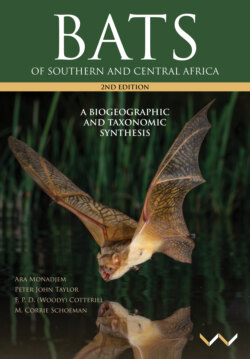Читать книгу Bats of Southern and Central Africa - Ara Monadjem - Страница 28
На сайте Литреса книга снята с продажи.
Crevice-roosting bats
ОглавлениеWhilst also roosting in natural situations under the bark of trees, in fissures of hollow trees or in rocky crevices, crevice-roosting bats (including the many species of Vespertilionidae and Molossidae) typically exploit crevices in built structures such as buildings and bridges (Skinner and Chimimba 2005, Jacobs and Barclay 2009, Voigt et al. 2016).
Figure 19. Schematic comparison of the diversity of different daylight domiciles selected by representative cavernicolous and rupicolous species of Chiroptera that roost in caves and rock crevices, respectively: A crevices in sloping inselbergs, Chaerephon ansorgei; B and C crevices in vertical precipices, Chaerephon major and Tadarida fulminans; D horizontal crevices, Tadarida aegyptiaca; E crevices in boulders at ground level, Chaerephon major and Sauromys petrophilus; F free-hanging in dimly illuminated caverns, often near entrance, Rousettus aegyptiacus; G cavities in roof, Myotis tricolor; H in contact, cavities high in ceiling, Miniopterus natalensis; I free-hanging from ceiling in pitch darkness, Rhinolophus spp.; J high roofs and walls, in contact, Macronycteris vittatus; K partially lit and well-ventilated boulder caves and overhangs, Rhinolophus fumigatus and Taphozous perforatus; L free-hanging from low ceiling, hot and humid, Hipposideros caffer. The scale at the bottom presents an index of the trend of ambient lighting within a cave, which underlies important differences between the roosts selected by cavernicolous bats (modified after Verschuren (1957a) and Brosset (1966a) with additions).
Buildings resemble caves in many ways and suitable buildings, usually the roof spaces, are readily exploited by bats (Figure 15). Although colonies of up to 2,000 Chaerephon pumilus have been estimated to occur in the roof of a sugar mill in KwaZulu-Natal, colonies of most house-dwelling bats are generally much smaller, from a few individuals to a few dozen. Information on dealing with unwanted roof-dwelling bats, as well as further details on where and how to locate bat roosting sites and exit holes within the roof space, are provided by Taylor (2000).
